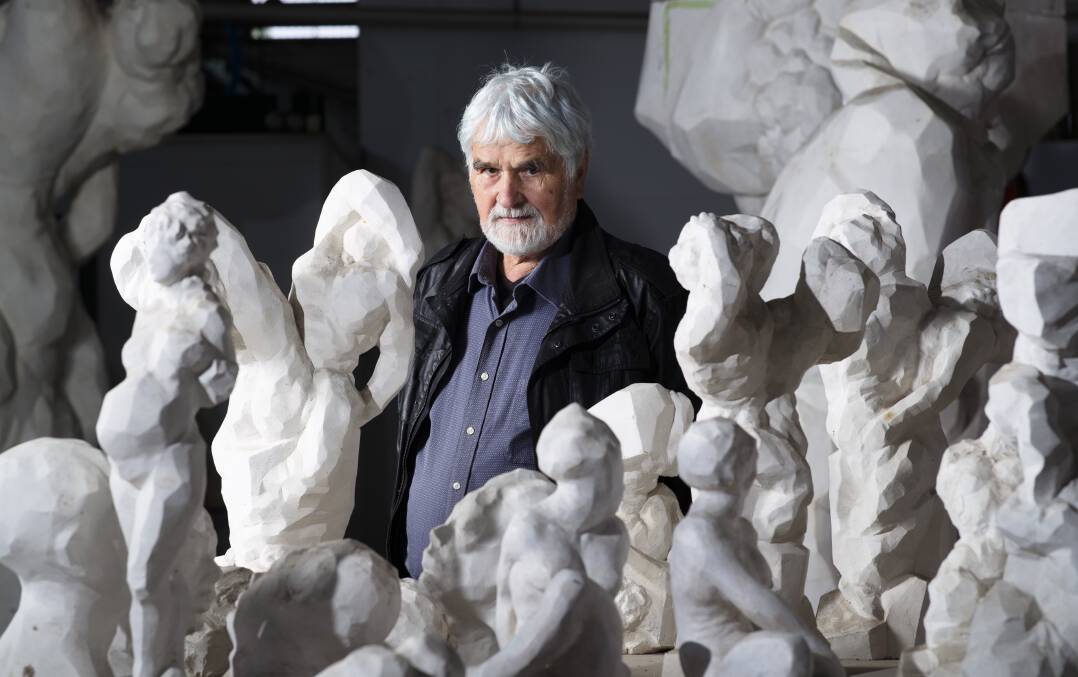Ante Dabro is 85. He attributes his good health and vitality to the grappa he offers me at 9.30 in the morning.
"It's a good one," he says in his vault of a studio at the Fairbairn side of the airport.
The Italian spirit is strong enough to fuel a lawnmower, and far too strong for even an aged journalist used to traditional journalists' ways.
But his enthusiasm is just the tonic.
His sculptures are dotted around Canberra and in collections all over the world. A biography is on the way. It will be quite a read.
You will have seen his work. He did the Royal Australian Navy Memorial on Anzac Parade and a large work - Resilience - on the corner of Binara Street and City Walk in Civic. There are some on the campus of the ANU and in the Brindabella Business Park next to the airport.
The sculptor left what was then Yugoslavia in 1967 as a fugitive from communism. In the west, the Yugoslav dictator Marshal Josip Tito was somewhat revered by the left as presenting a less inhuman side to communism than that in the Soviet Union.
But Ante Dabro will have none of it. Some of his friends disappeared under the regime.
He decided to disappear himself, to Canada, but thought he would call in on Croatian friends in Australia on the way. He liked Canberra so much that he stayed.

"I told myself, 'I'm not going until I master English', so I thought, 'I will work to learn'," he said.
He got jobs - at one stage, he was chiselling gravestones in Queanbeyan.
And his workmates taught him English. He remembers an incident when they told him to get some ice cream. Because his English was poor, one of them wrote on his hand what he should say to the young shop assistant. "I want six effing ice creams," he then said unknowingly to the shocked server, or words to that effect (he has mastered all shades of the English language by now).
The joke was on him - but it helped him like Canberrans.
They seem to have liked him. He learnt the vernacular quickly. "We went to the pub and they said, 'It's your shout'".
"What you mean 'shout'?" he replied. They explained and he learned.
As he drinks his grappa today, he has a pad in his hand and he doodles. Sometimes it becomes a sculpture and sometimes it becomes a crumpled ball in a waste-paper basket.
All around him are the plaster casts for the angular bronze sculptures which adorn the city, from the ANU campus to the airport to City Walk to the Royal Australian Navy Memorial on Anzac Parade. The technique is to make a mould of plaster and then use it to form the bronze final work.
Despite the popularity of his work, the snootier galleries look down on it. "I honestly couldn't give a damn if I'm ignored. I don't follow trends. It's superficial. It's artificial."
But he adds of his work: "I don't think history will ignore it."
He is a sculptor in the traditional mould. His hero is Michelangelo and he makes pilgrimages to Florence to see the great artist's work.
Italy is just across the water from what was once his homeland, Croatia, and he goes back there now and again. But he is not sentimental about it. He left the village where he was born in 1950 and the country in 1967 after compulsory service in the Yugoslav army. "That helped me make up my mind to leave."
But sculpture was in him from the age of nine. As a lad, he had to look after sheep. "I had a little carving knife. There was a stone - mulica - and I carved it into a bird in a nest."

When he got home, he put his first carving on the floor "and the cat came along and grabbed it. He thought it was a real bird, and people said 'There must be something to him'".
In Canberra, he signed up for art school to learn and then to teach. "You'll teach them sculpture. They'll teach you English," he was told. He taught at Deakin High School and was something of an eccentric there, with his big beard, big hair and deep European accent - "exotic" is how he describes himself.
But he tells a story of a difficult boy gravitating towards his classes to avoid uncongenial lessons. His mischief played to their mischief. He gave them purpose and he still sees old pupils.
Exhibitions followed - and sales. And age.
And maybe wisdom. He despairs of the tribal thinking of our age, and the way the Twitter mob falls on wrongthink.
"It's too dangerous these days to have a personal opinion," he said.
"I don't follow the rules. If I followed the rules, I would be back in a communist country from which I escaped."
He is married to "a lovely Australian girl. She's my mate, my wife and the mother of three kids".
"I'm 85. Do you know why?"
And he points to the bottle of grappa.
We've made it a whole lot easier for you to have your say. Our new comment platform requires only one log-in to access articles and to join the discussion on The Canberra Times website. Find out how to register so you can enjoy civil, friendly and engaging discussions. See our moderation policy here.



!["[T]he First and Fifth Amendments Require ICE to Provide Information About the Whereabouts of a Detained Person"](https://images.inkl.com/s3/publisher/cover/212/reason-cover.png?w=600)



